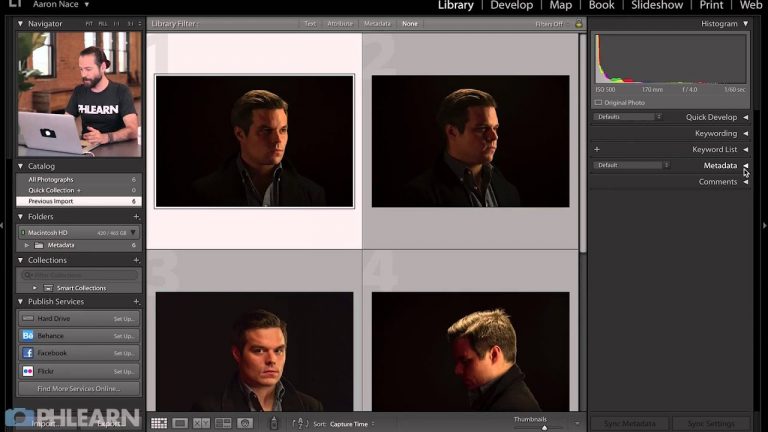
Alright photographers, it’s time to talk about using protection…copyright protection that is! Learn how to add metadata to photos in Lightroom!
Section 1: What is Metadata?
Metadata is information that is stored inside of an image file. It’s not visible when looking at a photo, but it includes information about when and how that photo was taken. You can ADD metadata to images to protect them with copyright information. If anyone downloads your image from online, your name will be forever stuck inside of that image. HA!
To see an example of what this looks like, right click on a photo and select “Get Info.” You can open up the “More Info” tab and see things like the aperture and shutter speed that the photo was taken at!
Metadata can be stored in multiple file formats: JPEG, RAW, DNG, TIFF, and PS files all include metadata.
Section 2: How to Add Metadata
First we add copyright information by going to the Metadata tab and selecting Preset – Edit Presets. Under the IPTC copyright section, include:
Copyright – Copyright symbol, Your name, All Rights Reserved
Copyright Status – Copyrighted
Rights Usage Terms – All Rights Reserved, No Reproduction Without Prior Permission
Copyright Info URL – Your website
Now, you can add the creator information. Under IPTC Creator, include (at the very least):
Creator – Your name
Creator City – Your city
Creator Email – Your email
Creator Website – Your website
Lastly, enter this information into the IPTC Status Section:
Credit Line – Your name, Your Company
Source – Your name
That’s it! Remember, these are the bare minimums in terms of information. It’s always better to have too much than not enough.
Section 3: Creating & Syncing Presets
To save all of this information that you just typed in (because who wants to do that over and over), go up to the top of your Edit Metadata Presets window and select “Save Current Settings as New Preset.” You can just name the Preset as your own name, or however you will remember it.
To apply that to all of you photos, select one and then change the Preset Drop Down to the one you just made! Then, Press “Sync Metadata” and it will apply it to every one of your images.
Section 4: Syncing During Import
Click on “Import” at the bottom left of Lightroom. Then select the desired images. Now, select your new preset by opening the “Apply During Import” tab and selecting it from the Metadata drop down menu.
You can also create a preset for this process (for the extra lazy ones). At the bottom of the screen there will be an Import Preset box; select “Save Current Settings as new Preset…” from the drop down menu. Now, you can name that preset and use it in the future!
Section 5: Keywords and Cataloging
Keywords are another type of metadata! These can be added in Lightroom so that it is easier to search for a specific kind of image. It’s great for efficient organization! Under the Keywording tab, you can type in any words you associate with your images. To apply those keywords to ALL of your photos, Shift + Click on all of the images. Then, You can click on the individual words in the “Keyword Set” Box. This will apply those words to all of your images.
Section 6: Checking Online
So, you’ve entered in all of this data but how do you know that it’s really there? Well, if you’d like to check beyond Lightroom or Finder, we have found just the thing for you.
Open a web browser and go to “Metapicz.com.” You can upload your files directly to this site and it will display all of the metadata held within that image!
Have fun and use protection!!
———————————————————————————————
Thanks for watching Phlearn! If you enjoyed this video be sure to subscribe to our channel so you don’t miss a thing!
Subscribe: http://goo.gl/LBIEQU
For more advanced Photoshop Tutorials be sure to check out our Phlearn PRO Tutorials. We offer the best Photoshop tutorials available starting at just $24.99.
http://phlearn.com/product-category/pro-photoshop-tutorials
———————————————————————————————-
Stock Images provided by: http://us.fotolia.com/